#BEST PYTHON TOOLS TO GET STARTED
Explore tagged Tumblr posts
Text
《Keep On》 - but with the Terrans!
This is a recreation of Digimon Adventure's ending scene with Earthspark characters :)
As a cross-fandom fan I've wanted to do this for a good while and eventually started working on the project in December, 2024. While it's not perfect and a lot of pieces are still missing, I decided that it's good enough for now and it's time to just post it. Also, this is actually for an International Children's Day (June 1) Chinese fandom event.
Details under the cut
OG Video
youtube
Tools I used
Art: Procreate
Animation: Figma (most of the complicated ones), Python (for creating gifs of simple animations), DaVinci Resolve (for putting the whole video together)
Components of the video
00:00 - 00:36
The first sequence is just the main character's silly faces, which is the most fun part to draw! And they already look adorable even without the rest of the video or any music.







I also need to create the flipping effects, which I initially attempted to do with Figma but realized that flipping 8 images at once overloads the tool and makes its animation laggy. I need them to all flip in sync, so this part is actually done with a Python script.

Compared to the OG video, the middle row is missing. I initially planned to draw the human Maltos but unfortunately ran out of time.
00:36 - 00:51
The second sequence provides an overview of 1) locations in the show, 2) side characters of the show, 3) iconic items that belong to the main characters.
For the locations, I took screenshots and edited them into having anime vibes:

Also had to distort the side characters' images so they follow a tilted route. The distortion part is also done with a Python script.
I initially planned to draw the following items for the Terrans but ran out of time:
Swords and housework star stickers for Twitch
Shield and balls for Thrash
Inventions (smart trainer / hologram projector) for Nightshade
Tablet and the director's viewfinder for Hashtag
Dinobot comics & dinosaur fossils for Jawbreaker
Contaminated energon cans for Aftermath
Cyber Slayer for Spitfire
Yeah the items for the Chaos Terrns are pretty cursed lmao, but I honestly can't think of anything else that are iconically theirs.
00:51 - 1:17 Roll out!
In the OG video this part is the main characters rolling out with their Digimon partners. For the Terrans, of course they will be rolling out with their mentor-ish counterparts. (I'm so sorry that Bumblebee wasn't included. You are the best mentor. But like, you are the shared mentor so it's kind hard to point to one Terran and declare you their specific mentor.)

At this point you probably already realized that the only characters that I do not run out of time for are the Terrans. And yeh, once again I run out of time for the Mentors and had to use low resolution stock images, screenshots, and even very inaccurate toy images.
I struggled to decide whether Starscream should stand by Hashtag or Spitfire, but Spitfire really doesn't have anyone besides Starscream so it had to be this way, which is again pretty cursed.
1:17 - 1:31
Turns out I do run out of time even for the Terrans! I was initially planning to draw the "everyone running towards the silver lining" scene but kinda suck at drawing animation. So have some Terrans dancing.
1:31 - 1:42
Hesitated between drawing "Terratronus getting armored up, each armor piece representing one Terrans" - which would be a perfect way to represent the ending of S3! But it'll probably look weird with a horizontal frame so I eventually just drew a traditional family photo.
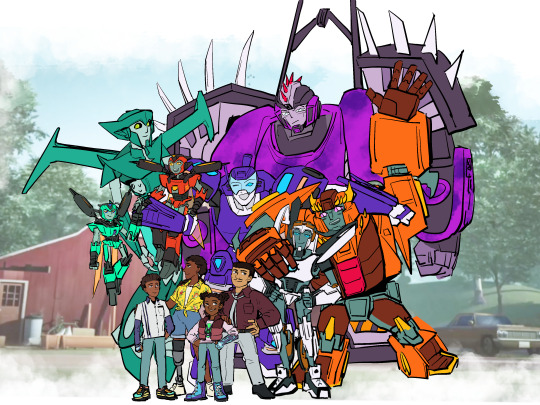
#transformers#earthspark#transformers earthspark#twitch malto#thrash malto#nightshade malto#hashtag malto#jawbreaker malto#aftermath#spitfire#es aftermath#es spitfire#chaos terran aftermath#chaos terran spitfire#I actually want to make a version with my Chaos Terrans as well!!#maybe next time :3#my art#my video#my animation#digimon homage#digimon keep on#Youtube
70 notes
·
View notes
Text
Python for Beginners: Launch Your Tech Career with Coding Skills
Are you ready to launch your tech career but don’t know where to start? Learning Python is one of the best ways to break into the world of technology—even if you have zero coding experience.
In this guide, we’ll explore how Python for beginners can be your gateway to a rewarding career in software development, data science, automation, and more.
Why Python Is the Perfect Language for Beginners
Python has become the go-to programming language for beginners and professionals alike—and for good reason:
Simple syntax: Python reads like plain English, making it easy to learn.
High demand: Industries spanning the spectrum are actively seeking Python developers to fuel their technological advancements.
Versatile applications: Python's versatility shines as it powers everything from crafting websites to driving artificial intelligence and dissecting data.
Whether you want to become a software developer, data analyst, or AI engineer, Python lays the foundation.
What Can You Do With Python?
Python is not just a beginner language—it’s a career-building tool. Here are just a few career paths where Python is essential:
Web Development: Frameworks like Django and Flask make it easy to build powerful web applications. You can even enroll in a Python Course in Kochi to gain hands-on experience with real-world web projects.
Data Science & Analytics: For professionals tackling data analysis and visualization, the Python ecosystem, featuring powerhouses like Pandas, NumPy, and Matplotlib, sets the benchmark.
Machine Learning & AI: Spearheading advancements in artificial intelligence development, Python boasts powerful tools such as TensorFlow and scikit-learn.
Automation & Scripting: Simple yet effective Python scripts offer a pathway to amplified efficiency by automating routine workflows.
Cybersecurity & Networking: The application of Python is expanding into crucial domains such as ethical hacking, penetration testing, and the automation of network processes.
How to Get Started with Python
Starting your Python journey doesn't require a computer science degree. Success hinges on a focused commitment combined with a thoughtfully structured educational approach.
Step 1: Install Python
Download and install Python from python.org. It's free and available for all platforms.
Step 2: Choose an IDE
Use beginner-friendly tools like Thonny, PyCharm, or VS Code to write your code.
Step 3: Learn the Basics
Focus on:
Variables and data types
Conditional statements
Loops
Functions
Lists and dictionaries
If you prefer guided learning, a reputable Python Institute in Kochi can offer structured programs and mentorship to help you grasp core concepts efficiently.
Step 4: Build Projects
Learning by doing is key. Start small:
Build a calculator
Automate file organization
Create a to-do list app
As your skills grow, you can tackle more complex projects like data dashboards or web apps.
How Python Skills Can Boost Your Career
Adding Python to your resume instantly opens up new opportunities. Here's how it helps:
Higher employability: Python is one of the top 3 most in-demand programming languages.
Better salaries: Python developers earn competitive salaries across the globe.
Remote job opportunities: Many Python-related jobs are available remotely, offering flexibility.
Even if you're not aiming to be a full-time developer, Python skills can enhance careers in marketing, finance, research, and product management.
If you're serious about starting a career in tech, learning Python is the smartest first step you can take. It’s beginner-friendly, powerful, and widely used across industries.
Whether you're a student, job switcher, or just curious about programming, Python for beginners can unlock countless career opportunities. Invest time in learning today—and start building the future you want in tech.
Globally recognized as a premier educational hub, DataMites Institute delivers in-depth training programs across the pivotal fields of data science, artificial intelligence, and machine learning. They provide expert-led courses designed for both beginners and professionals aiming to boost their careers.
Python Modules Explained - Different Types and Functions - Python Tutorial
youtube
#python course#python training#python#learnpython#pythoncourseinindia#pythoncourseinkochi#pythoninstitute#python for data science#Youtube
3 notes
·
View notes
Text
How to Build Software Projects for Beginners

Building software projects is one of the best ways to learn programming and gain practical experience. Whether you want to enhance your resume or simply enjoy coding, starting your own project can be incredibly rewarding. Here’s a step-by-step guide to help you get started.
1. Choose Your Project Idea
Select a project that interests you and is appropriate for your skill level. Here are some ideas:
To-do list application
Personal blog or portfolio website
Weather app using a public API
Simple game (like Tic-Tac-Toe)
2. Define the Scope
Outline what features you want in your project. Start small and focus on the minimum viable product (MVP) — the simplest version of your idea that is still functional. You can always add more features later!
3. Choose the Right Tools and Technologies
Based on your project, choose the appropriate programming languages, frameworks, and tools:
Web Development: HTML, CSS, JavaScript, React, or Django
Mobile Development: Flutter, React Native, or native languages (Java/Kotlin for Android, Swift for iOS)
Game Development: Unity (C#), Godot (GDScript), or Pygame (Python)
4. Set Up Your Development Environment
Install the necessary software and tools:
Code editor (e.g., Visual Studio Code, Atom, or Sublime Text)
Version control (e.g., Git and GitHub for collaboration and backup)
Frameworks and libraries (install via package managers like npm, pip, or gems)
5. Break Down the Project into Tasks
Divide your project into smaller, manageable tasks. Create a to-do list or use project management tools like Trello or Asana to keep track of your progress.
6. Start Coding!
Begin with the core functionality of your project. Don’t worry about perfection at this stage. Focus on getting your code to work, and remember to:
Write clean, readable code
Test your code frequently
Commit your changes regularly using Git
7. Test and Debug
Once you have a working version, thoroughly test it. Look for bugs and fix any issues you encounter. Testing ensures your software functions correctly and provides a better user experience.
8. Seek Feedback
Share your project with friends, family, or online communities. Feedback can provide valuable insights and suggestions for improvement. Consider platforms like GitHub to showcase your work and get input from other developers.
9. Iterate and Improve
Based on feedback, make improvements and add new features. Software development is an iterative process, so don’t hesitate to refine your project continuously.
10. Document Your Work
Write documentation for your project. Include instructions on how to set it up, use it, and contribute. Good documentation helps others understand your project and can attract potential collaborators.
Conclusion
Building software projects is a fantastic way to learn and grow as a developer. Follow these steps, stay persistent, and enjoy the process. Remember, every project is a learning experience that will enhance your skills and confidence!
3 notes
·
View notes
Text
Check-in for 01/28/24
It's been a while since I did one of these. Time to remedy that!
I've been doing well in my assignments, but due to some registration issues at the start of the semester I was unable to sign up for any web development or programming classes :< It's nice to take a break, but I'm really worried about getting stagnant in those skills, and maybe even losing what I've learned over time.
This is where a couple of new projects come in: A blorbo database and a tool for drawing pokemon from memory. These things are going to keep me avoid stagnancy and help me develop my web dev and Python programming skills, and I'm real excited to talk about them.

First up, let's talk about that tool for drawing pokemon from memory. I love drawing pokemon from memory, but it's a bit of a struggle to find tools online that work well for a solo experience when you're doing this challenge alone. So I made a program in PyGame to solve this problem, and I've actually already completed it! It was a great learning experience when it came to getting a taste of APIs, and PokeAPI really helped me do all the heavy lifting with it. I also ended up using ChatGPT to help me understand how to phrase my questions and the things I needed to research. This is the end result:

If you click "Get Random Pokemon", the program will provide a pokemon's name. The point of it is to draw the pokemon as best as you remember it, and then click "Show Pokemon Image" to see how you did. You will then have the option to get a new random pokemon, which clears the image from the window.


There's a lot of stuff I don't understand about how the program works--- APIs evade my understanding, and Tkinter is a dark art beyond my comprehension. But I was able to make a program that solved a genuine problem for me for the first time, and that's super exciting to me!
Now, for web development--- long story short, I'm making a website dedicated to cataloguing my OCs that's very much inspired by tumblr user @snekkerdoodles's personal site on neocities, which I regularly stare at in an effort to motivate myself to make cool things like it (everyone reading this should check his page out IMMEDIATELY and tell him how cool it is). Here's the screenshots of the WIP I'm chipping away at right now:

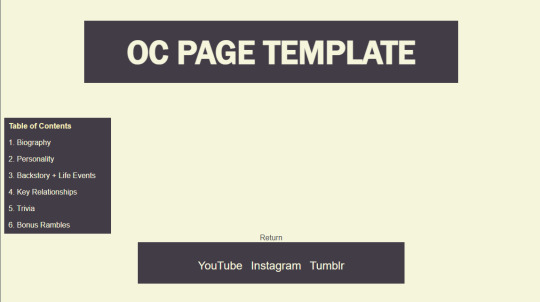
I don't have much to say about it, as the interesting stuff will really be the content of the pages, and I still have yet to finish the template page I'll be filling with my OCs' information. However, I can say that I'm very upset with the lack of proper teaching that took place in the first (and currently only) college web dev class I've taken. I spent an entire semester doing my own research to learn everything they were supposed to be teaching us. I'm still very peeved about that.
To summarize this very rambling post I'm too sleepy to edit properly, I'm making a digital blorbo encyclopedia, and I finished making a little desktop app thingy, which means I need to summon a new programming project. I'm tempted to make it a video game... maybe I should turn back to that visual novel idea I had ages ago and boot up RenPy!
#let me know if you'd prefer I untag you!#I'm still so uncertain of tagging etiquette on Tumblr#stuff by sofie#sofie checks in#web developers#web development#web dev#programming#coding#codeblr#python#software development#app development#pygame
32 notes
·
View notes
Text
instagram
Hey there! 🚀 Becoming a data analyst is an awesome journey! Here’s a roadmap for you:
1. Start with the Basics 📚:
- Dive into the basics of data analysis and statistics. 📊
- Platforms like Learnbay (Data Analytics Certification Program For Non-Tech Professionals), Edx, and Intellipaat offer fantastic courses. Check them out! 🎓
2. Master Excel 📈:
- Excel is your best friend! Learn to crunch numbers and create killer spreadsheets. 📊🔢
3. Get Hands-on with Tools 🛠️:
- Familiarize yourself with data analysis tools like SQL, Python, and R. Pluralsight has some great courses to level up your skills! 🐍📊
4. Data Visualization 📊:
- Learn to tell a story with your data. Tools like Tableau and Power BI can be game-changers! 📈📉
5. Build a Solid Foundation 🏗️:
- Understand databases, data cleaning, and data wrangling. It’s the backbone of effective analysis! 💪🔍
6. Machine Learning Basics 🤖:
- Get a taste of machine learning concepts. It’s not mandatory but can be a huge plus! 🤓🤖
7. Projects, Projects, Projects! 🚀:
- Apply your skills to real-world projects. It’s the best way to learn and showcase your abilities! 🌐💻
8. Networking is Key 👥:
- Connect with fellow data enthusiasts on LinkedIn, attend meetups, and join relevant communities. Networking opens doors! 🌐👋
9. Certifications 📜:
- Consider getting certified. It adds credibility to your profile. 🎓💼
10. Stay Updated 🔄:
- The data world evolves fast. Keep learning and stay up-to-date with the latest trends and technologies. 📆🚀
. . .
#programming#programmers#developers#mobiledeveloper#softwaredeveloper#devlife#coding.#setup#icelatte#iceamericano#data analyst road map#data scientist#data#big data#data engineer#data management#machinelearning#technology#data analytics#Instagram
8 notes
·
View notes
Text
Why Every Student Should Participate in a Hackathon
In today’s fast-paced digital world, the ability to solve problems creatively is just as important as technical skills. This is where a hackathon shines. Whether you're a developer, designer, or business-minded thinker, a hackathon gives you a unique platform to showcase your talent, build new skills, and contribute to innovative projects—often in just 48 hours.
If you're a student, participating in a hackathon might just be the smartest decision you can make for your personal and professional growth.
What is a Hackathon?
A hackathon is a collaborative event where teams work together intensively over a short period—usually one to three days—to build a project from scratch. While coding is a central part, modern hackathons welcome all kinds of talents: UI/UX designers, content creators, marketers, and product thinkers.
Hackathons often come with themes—like sustainability, mental health, AI, fintech, or social impact—which help guide participants to build projects around real-world challenges.
The Student Advantage: Why Join a Hackathon?
If you’re still in college or university, here are a few solid reasons to sign up for your first hackathon:
1. Learn by Doing
A hackathon is one of the best places to learn hands-on. You’ll get to apply classroom theories to real-world projects, often learning more in one weekend than in an entire semester. You’ll also pick up new tools, technologies, and frameworks on the go.
2. Build Your Resume and Portfolio
Participation in a hackathon instantly boosts your resume. Employers love to see initiative, teamwork, and problem-solving skills—all of which are demonstrated by joining a hackathon. If you create something impactful, it could even become a long-term project or startup idea.
3. Network with Industry Experts
Many hackathons feature mentors from top companies and industries. This is your chance to ask questions, get feedback, and even connect with potential recruiters. Some companies even hire interns or offer job interviews during or after the event.
4. Win Prizes and Scholarships
While not the main goal, many hackathons offer cash prizes, internships, tech gadgets, and free software licenses. Some also provide travel scholarships or job offers to outstanding teams.
5. Collaborate and Build Friendships
You’ll work closely with peers from different departments or even universities. Hackathons foster a spirit of teamwork and trust—and you may just walk away with lifelong friends or co-founders.
How to Prepare for Your First Hackathon
Pick your tools early: Whether it's Python, React, Figma, or Firebase, be comfortable with at least one or two tools.
Form a balanced team: Find people with different strengths—developers, designers, and storytellers.
Have a problem-first mindset: Instead of jumping into building, understand the user and the issue deeply.
Practice your pitch: Your idea might be amazing, but if you can’t explain it well in 2-3 minutes, judges may miss its value.
Stay open-minded: Hackathons are chaotic and dynamic. Be ready to learn, adapt, and pivot.
Choosing the Right Hackathon as a Student
There are thousands of hackathons held worldwide every year—on campuses, online, or hosted by organizations. Look for events that welcome beginners and provide mentorship. Sites like Devpost, MLH (Major League Hacking), HackerEarth, and local student communities are great places to start.
Also consider themed hackathons like:
Education hackathons for building student-focused tools
Green tech hackathons for solving climate problems
AI hackathons for machine learning enthusiasts
Conclusion
A hackathon is more than just an event—it’s an experience. It pushes your limits, grows your skills, and opens up new opportunities. As a student, you have nothing to lose and everything to gain. So step out of the classroom and into the hackathon arena. You might just discover your next passion, your dream job, or the idea that changes the world.
2 notes
·
View notes
Text
What’s the Big Deal About Python?
If you’ve been around the tech world even for a minute, you’ve probably heard people raving about Python. No, not the snake, we’re talking about the programming language. But what’s so special about it? Why is everyone from beginner coders to AI researchers using Python like it’s their best friend? Let’s break it down in simple words.

Easy to Learn, Easy to Use
First things first, Python is super easy to learn. The code looks almost like regular English, which means you don’t have to memorize weird symbols or endless rules. If you’re just starting your programming journey, Python won’t scare you away.
For example, printing a sentence in Python is as simple as:

That’s it. No extra setup, no confusing syntax. It just works.
Used Everywhere
Python isn’t just for small scripts or learning projects. It’s everywhere, web development, data science, automation, artificial intelligence, game development, even robotics.
Big companies like Google, Netflix, and Instagram use Python behind the scenes to make their products work better.
Huge Library Support
One of the best things about Python is its rich library ecosystem. Libraries are like pre-written tools that help you do complex stuff without writing all the code yourself. Want to analyze data? Use Pandas. Want to build a web app? Try Django or Flask. Want to build a chatbot or train a machine learning model? There’s TensorFlow and PyTorch for that.
Great Community
Python has a massive community. That means if you ever get stuck, there’s a good chance someone has already solved your problem and posted about it online. You’ll find tons of tutorials, forums, and helpful folks willing to guide you.
Not the Fastest, But Fast Enough
Python isn’t the fastest language out there — it’s not meant for super high-speed system-level programming. But for most tasks, it’s more than fast enough. And if you really need to speed things up, there are ways to connect Python with faster languages like C or C++.
So, Should You Learn Python?
Absolutely. Whether you’re a student, a hobbyist, or someone switching careers, Python is a great place to start. It’s beginner friendly, powerful, and widely used. You’ll be surprised how much you can build with just a few lines of Python code.
2 notes
·
View notes
Text
How to Learn Programming?
Learning to code can be a rewarding and empowering journey. Here are some steps to help you get started:
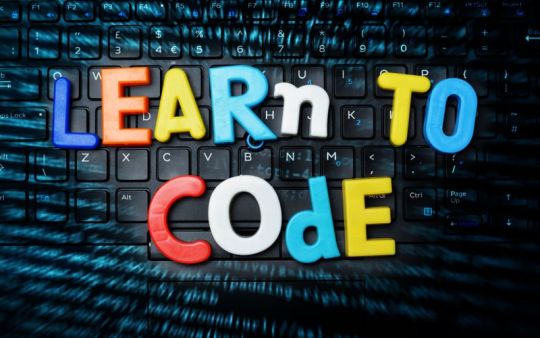
Define Your Purpose:
Understand why you want to learn to code. Whether it's for a career change, personal projects, or just for fun, having a clear goal will guide your learning path.
Choose a Programming Language:
Select a language based on your goals. For beginners, languages like Python, JavaScript, or Ruby are often recommended due to their readability and versatility.
Start with the Basics:
Familiarize yourself with fundamental concepts such as variables, data types, loops, and conditional statements. Online platforms like Codecademy, Khan Academy, or freeCodeCamp offer interactive lessons.
Practice Regularly:
Coding is a skill that improves with practice. Set aside dedicated time each day or week to code and reinforce what you've learned.
Build Simple Projects:
Apply your knowledge by working on small projects. This helps you gain hands-on experience and keeps you motivated.
Read Code:
Study existing code, whether it's open-source projects or examples in documentation. This helps you understand different coding styles and best practices.
Ask for Help:
Don't hesitate to ask questions on forums like Stack Overflow or Reddit when you encounter difficulties. Learning from others and getting feedback is crucial.
Join Coding Communities:
Engage with the coding community to stay motivated and learn from others. Platforms like GitHub, Stack Overflow, and coding forums provide opportunities to connect with fellow learners and experienced developers.
Explore Specializations:
As you gain more experience, explore different areas like web development, data science, machine learning, or mobile app development. Specializing can open up more opportunities and align with your interests.
Read Documentation:
Learn to navigate documentation for programming languages and libraries. It's a crucial skill for developers, as it helps you understand how to use different tools and resources effectively.
Stay Updated:
The tech industry evolves rapidly. Follow coding blogs, subscribe to newsletters, and stay informed about new developments and best practices.
Build a Portfolio:
Showcase your projects on platforms like GitHub to create a portfolio. It demonstrates your skills to potential employers or collaborators.
Remember, learning to code is a continuous process, and it's okay to face challenges along the way. Stay persistent, break down complex problems, and celebrate small victories.
7 notes
·
View notes
Text
Codetober Day #9
9. What kind of stuff do you like to program?
When I'm not starting and stopping several projects at once, I think my favorite thing to work on in general are applications that compile and make info for my favorite games accessible. For example, one of my favorite (though still woefully unfinished) projects was a discord bot that would make the information for Pathfinder v2 easy to access through various commands. For some reason, the projects that scratch my brain in the best possible way are ones that can retrieve and present information related to gaming and my other nerdy hobbies. To that end, I've found Python to be a pretty great tool for that. I'm kinda hoping that some day I could get work in that, but that's a different story.
8 notes
·
View notes
Text
Unlock 50% Off Your Image Processing Assignment Order Today!
Are you struggling with your image processing assignments? Look no further! At matlabassignmentexperts.com, we provide the best image processing assignment help online. We are excited to introduce a fantastic offer that will make getting expert help even more rewarding.
Special Offer Details:
For a limited time, we are offering a unique opportunity to our valued customers: Refer a Friend and receive a staggering 50% discount on your next assignment with us. This means that not only will you receive top-notch assignment assistance from our seasoned experts, but you'll also enjoy significant savings on your academic expenses.
How to Redeem: Redeeming this offer is simple:
Refer a Friend: Spread the word about matlabassignmentexperts.com to your friends and classmates who might benefit from our services.
Enjoy Your Discount: Once your referred friend places an order with us, you automatically qualify for the 50% discount on your next assignment. It's that easy!

Why Choose Matlabassignmentexperts.com?
Expertise in Image Processing: Our team consists of experienced professionals with a deep understanding of image processing concepts and techniques. Whether it's MATLAB, Python, or any other tool, we deliver solutions that exceed expectations.
Quality Assurance: We prioritize quality above all else. Every assignment undergoes meticulous review to ensure accuracy, clarity, and adherence to your requirements.
Customer Satisfaction: Our commitment to your satisfaction drives everything we do. From timely delivery to responsive customer support, we are dedicated to providing a seamless experience.
Don't miss out on this incredible opportunity to secure expert assistance at an unbeatable price. Place your image processing assignment order with matlabassignmentexperts.com today and take advantage of our Refer a Friend offer to enjoy a 50% discount on your next assignment. Contact us now to get started!
Reach out to us at matlabassignmentexperts.com for any inquiries or to place your order. Let's simplify your academic journey together!
#assignment help#education#matlab assignment help#help with assignments#students#university#image processing assignment help
2 notes
·
View notes
Text

Skywave Linux v5 is Now on Debian Sid!
Enjoy shortwave radio and overseas broadcasts, no matter where you are. Skywave Linux brings the signals to you. Broadcasting, amateur radio, maritime, and military signals are available at your fingertips.
Skywave Linux is a free and live computing environment you boot from a flash drive on your PC. Start it up, pick a radio server somewhere in the world, and tune in some stations.
Skywave Linux brings you the signals, whether or not you have a big outdoor antenna or can afford an expensive communications receiver. Hundreds and hundreds of volunteer operated radio servers are on the internet, which let you tune the airwaves and pick up broadcasts in excellent locations and on high performance equipment.
If you are into FT-8, PSK-31, JT-65, or other digimodes, you can decode the signals in Skywave Linux. It also has tools for decoding weather satellites, ACARS, and ADS-B signals.
Not only is Skywave Linux a prime system for software defined radio, but also for programming and coding. It has the Neovim editor and support for several programming languages: Python, Lua, Go, and Javascript. It is a great system for Web developers.
Debian Sid is now the base operating system which Skywave Linux builds upon. It is debloated, tuned, and tweaked for speed, so that you get the best possible computing performance. It works nicely on old laptops; it is super fast on a multi core, high spec PC.
For shortwave listening, weather satellite decoding, or airband monitoring, Skywave Linux is the system you want!

4 notes
·
View notes
Text
DevOps for Beginners: Navigating the Learning Landscape
DevOps, a revolutionary approach in the software industry, bridges the gap between development and operations by emphasizing collaboration and automation. For beginners, entering the world of DevOps might seem like a daunting task, but it doesn't have to be. In this blog, we'll provide you with a step-by-step guide to learn DevOps, from understanding its core philosophy to gaining hands-on experience with essential tools and cloud platforms. By the end of this journey, you'll be well on your way to mastering the art of DevOps.

The Beginner's Path to DevOps Mastery:
1. Grasp the DevOps Philosophy:
Start with the Basics: DevOps is more than just a set of tools; it's a cultural shift in how software development and IT operations work together. Begin your journey by understanding the fundamental principles of DevOps, which include collaboration, automation, and delivering value to customers.
2. Get to Know Key DevOps Tools:
Version Control: One of the first steps in DevOps is learning about version control systems like Git. These tools help you track changes in code, collaborate with team members, and manage code repositories effectively.
Continuous Integration/Continuous Deployment (CI/CD): Dive into CI/CD tools like Jenkins and GitLab CI. These tools automate the building and deployment of software, ensuring a smooth and efficient development pipeline.
Configuration Management: Gain proficiency in configuration management tools such as Ansible, Puppet, or Chef. These tools automate server provisioning and configuration, allowing for consistent and reliable infrastructure management.
Containerization and Orchestration: Explore containerization using Docker and container orchestration with Kubernetes. These technologies are integral to managing and scaling applications in a DevOps environment.
3. Learn Scripting and Coding:
Scripting Languages: DevOps engineers often use scripting languages such as Python, Ruby, or Bash to automate tasks and configure systems. Learning the basics of one or more of these languages is crucial.
Infrastructure as Code (IaC): Delve into Infrastructure as Code (IaC) tools like Terraform or AWS CloudFormation. IaC allows you to define and provision infrastructure using code, streamlining resource management.
4. Build Skills in Cloud Services:
Cloud Platforms: Learn about the main cloud providers, such as AWS, Azure, or Google Cloud. Discover the creation, configuration, and management of cloud resources. These skills are essential as DevOps often involves deploying and managing applications in the cloud.
DevOps in the Cloud: Explore how DevOps practices can be applied within a cloud environment. Utilize services like AWS Elastic Beanstalk or Azure DevOps for automated application deployments, scaling, and management.
5. Gain Hands-On Experience:
Personal Projects: Put your knowledge to the test by working on personal projects. Create a small web application, set up a CI/CD pipeline for it, or automate server configurations. Hands-on practice is invaluable for gaining real-world experience.
Open Source Contributions: Participate in open source DevOps initiatives. Collaborating with experienced professionals and contributing to real-world projects can accelerate your learning and provide insights into industry best practices.
6. Enroll in DevOps Courses:
Structured Learning: Consider enrolling in DevOps courses or training programs to ensure a structured learning experience. Institutions like ACTE Technologies offer comprehensive DevOps training programs designed to provide hands-on experience and real-world examples. These courses cater to beginners and advanced learners, ensuring you acquire practical skills in DevOps.

In your quest to master the art of DevOps, structured training can be a game-changer. ACTE Technologies, a renowned training institution, offers comprehensive DevOps training programs that cater to learners at all levels. Whether you're starting from scratch or enhancing your existing skills, ACTE Technologies can guide you efficiently and effectively in your DevOps journey. DevOps is a transformative approach in the world of software development, and it's accessible to beginners with the right roadmap. By understanding its core philosophy, exploring key tools, gaining hands-on experience, and considering structured training, you can embark on a rewarding journey to master DevOps and become an invaluable asset in the tech industry.
7 notes
·
View notes
Text
Journey to Devops
The concept of “DevOps” has been gaining traction in the IT sector for a couple of years. It involves promoting teamwork and interaction, between software developers and IT operations groups to enhance the speed and reliability of software delivery. This strategy has become widely accepted as companies strive to provide software to meet customer needs and maintain an edge, in the industry. In this article we will explore the elements of becoming a DevOps Engineer.
Step 1: Get familiar with the basics of Software Development and IT Operations:
In order to pursue a career as a DevOps Engineer it is crucial to possess a grasp of software development and IT operations. Familiarity with programming languages like Python, Java, Ruby or PHP is essential. Additionally, having knowledge about operating systems, databases and networking is vital.
Step 2: Learn the principles of DevOps:
It is crucial to comprehend and apply the principles of DevOps. Automation, continuous integration, continuous deployment and continuous monitoring are aspects that need to be understood and implemented. It is vital to learn how these principles function and how to carry them out efficiently.
Step 3: Familiarize yourself with the DevOps toolchain:
Git: Git, a distributed version control system is extensively utilized by DevOps teams, for code repository management. It aids in monitoring code alterations facilitating collaboration, among team members and preserving a record of modifications made to the codebase.
Ansible: Ansible is an open source tool used for managing configurations deploying applications and automating tasks. It simplifies infrastructure management. Saves time when performing tasks.
Docker: Docker, on the other hand is a platform for containerization that allows DevOps engineers to bundle applications and dependencies into containers. This ensures consistency and compatibility across environments from development, to production.
Kubernetes: Kubernetes is an open-source container orchestration platform that helps manage and scale containers. It helps automate the deployment, scaling, and management of applications and micro-services.
Jenkins: Jenkins is an open-source automation server that helps automate the process of building, testing, and deploying software. It helps to automate repetitive tasks and improve the speed and efficiency of the software delivery process.
Nagios: Nagios is an open-source monitoring tool that helps us monitor the health and performance of our IT infrastructure. It also helps us to identify and resolve issues in real-time and ensure the high availability and reliability of IT systems as well.
Terraform: Terraform is an infrastructure as code (IAC) tool that helps manage and provision IT infrastructure. It helps us automate the process of provisioning and configuring IT resources and ensures consistency between development and production environments.
Step 4: Gain practical experience:
The best way to gain practical experience is by working on real projects and bootcamps. You can start by contributing to open-source projects or participating in coding challenges and hackathons. You can also attend workshops and online courses to improve your skills.
Step 5: Get certified:
Getting certified in DevOps can help you stand out from the crowd and showcase your expertise to various people. Some of the most popular certifications are:
Certified Kubernetes Administrator (CKA)
AWS Certified DevOps Engineer
Microsoft Certified: Azure DevOps Engineer Expert
AWS Certified Cloud Practitioner
Step 6: Build a strong professional network:
Networking is one of the most important parts of becoming a DevOps Engineer. You can join online communities, attend conferences, join webinars and connect with other professionals in the field. This will help you stay up-to-date with the latest developments and also help you find job opportunities and success.
Conclusion:
You can start your journey towards a successful career in DevOps. The most important thing is to be passionate about your work and continuously learn and improve your skills. With the right skills, experience, and network, you can achieve great success in this field and earn valuable experience.
2 notes
·
View notes
Text
Getting Started with Full-Stack Web Development: Obstacles and Opportunities
Embarking on the journey to becoming a full-stack web developer offers a blend of exhilarating challenges and rewarding accomplishments. In this guide, we'll explore the intricacies of mastering full-stack development, delving into the obstacles you may face along the way and the triumphs that await those who persevere.
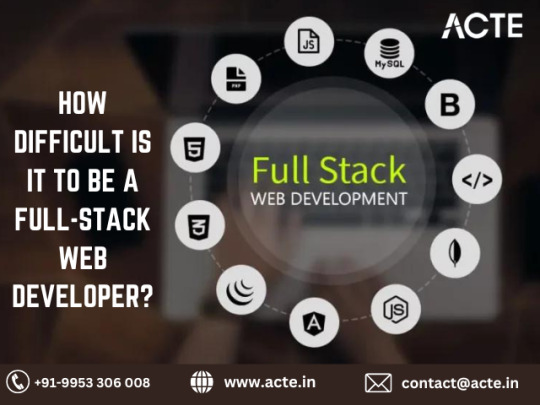
Introduction
Mastering full-stack web development is akin to embarking on a thrilling adventure—one that promises countless opportunities for growth, innovation, and professional fulfillment. However, the road to proficiency is not without its hurdles. In this blog, we'll navigate through the challenges aspiring full-stack developers may encounter, as well as the triumphs that come with overcoming them.
1. Diverse Skill Set
Full-stack web development demands proficiency in a diverse range of skills, spanning from frontend technologies like HTML, CSS, and JavaScript to backend languages such as Python, Ruby, or Node.js. Additionally, expertise in databases, server management, and deployment processes is crucial. Acquiring mastery in these areas requires dedication, time, and a continuous commitment to learning and adaptation.
2. Ever-Evolving Landscape
The realm of web development is in a perpetual state of evolution, with new frameworks, libraries, and tools emerging at a rapid pace. Keeping pace with these advancements and constantly updating your skill set is imperative to remain competitive in the industry. Allocate time to explore emerging technologies, enroll in online courses, and engage with the developer community to stay ahead of the curve.
3. Complexity of Projects
Full-stack developers often tackle intricate projects that necessitate the integration of various technologies and components. Managing the intricacies of these projects, troubleshooting issues, and ensuring seamless interaction between frontend and backend systems can be daunting. Nonetheless, overcoming these challenges cultivates invaluable problem-solving skills and deepens your comprehension of web development principles.
4. In-Depth Understanding
To excel as a full-stack developer, a profound understanding of programming concepts, algorithms, and data structures is indispensable. Mastery of these foundational principles empowers you to write concise, efficient code and tackle complex technical challenges with confidence. Dedicate time to delve into computer science fundamentals and engage in coding exercises to fortify your expertise.
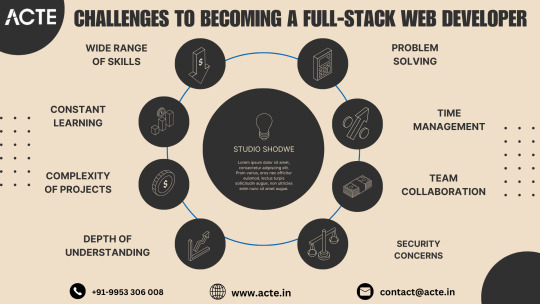
5. Effective Problem Solving
Effective problem-solving is a hallmark of successful full-stack developers. Debugging code, identifying bottlenecks, and optimizing performance demand astute analytical skills and a systematic approach. Collaborating with peers, leveraging online resources, and seeking mentorship can facilitate the navigation of complex technical hurdles and yield effective solutions.
6. Strategic Time Management
Balancing multiple responsibilities, including frontend and backend development, database management, and project deployment, necessitates adept time management skills. Prioritize tasks, establish realistic timelines, and leverage productivity tools to streamline your workflow and maximize productivity. Reserve time for ongoing learning and professional development to continually enhance your skill set.
7. Cultivating Team Collaboration
Full-stack developers often collaborate with interdisciplinary teams, comprising designers, frontend developers, backend developers, and other stakeholders. Effective communication, teamwork, and collaboration are vital for project success. Foster strong interpersonal relationships, actively contribute in team settings, and cultivate a culture of open communication and collaboration within your team.
8. Prioritizing Security
Understanding security best practices and implementing robust security measures is paramount in web development. Full-stack developers must remain vigilant in identifying and mitigating security vulnerabilities to safeguard sensitive data and uphold the integrity of web applications. Stay informed about prevalent security threats, adhere to industry best practices, and consistently update your knowledge to proactively address emerging risks.
Conclusion
Embarking on the journey to becoming a full-stack web developer is a thrilling endeavor marked by challenges and triumphs. By embracing the obstacles, refining your skills, and maintaining a steadfast commitment to learning and growth, you can unlock a realm of opportunities and embark on a gratifying career in web development. Remember, each challenge surmounted brings you closer to mastery, and the journey itself is as enriching as the destination.
#full stack developer#education#information#full stack web development#web development#front end development#full stack developer course#technology#backend
2 notes
·
View notes
Text
Are There Chances of Chatgpt Replacing Programmers?

Artificial Intelligence (AI) is creating waves across various industries including the tech industry. The emergence of the various language models that include Chatgpt has left may wondering whether AI will be replacing the programmers. Chatgpt is a natural language chatbot that helps people write emails, college essays, song lyrics etc. Some of the earliest users of chatgpt have even used it to write the python code. The popularity of chatgpt has grown because of its practical applications. The question that however arises here is whether it will be able to replace the developers and the writers just as computers and robots have replaced cashiers and assembly line workers or perhaps the taxi drivers in the future. If you are interested in understanding how you can improve your work with chatgpt, you can pursue a good Search Engine Marketing Course In Gurugram.
Reasons for The Growing Popularity of Chatgpt
Chatgpt has been able to impress several people as it is able to simulate human conversations and also sounds quite knowledgeable. Chatgpt has been developed by OpenAI which is the creator of the most popular text to image AI engine called Dall- E. Chatgpt uses algorithms that helps in analysing and humans fine tune the system’s training to respond to the questions of the user with full sentences that sound similar to that of human beings.
Statistics Related to Chatgpt
A recent paper that was published by OpenAI revealed that as many as 80% of the US workforce have a minimum of 10% of their tasks affected by Chatgpt and other language models. Another research revealed that as many as 20% of the workers will find that 50% of their tasks will get affected by AI. If you want to become a web designer, you can get in touch with the best Search engine marketing institute in Gurgaon. Here you will get to learn about the use of chatgpt in the best way so that you are able to stay ahead in the competition.
The programmers can be relieved for now as it is not among the hundred professions that are going to be impacted by Chatgpt. Some of the professions that will be impacted include:
Why Will It Not Affect The Programmers?
Though Chatgpt is able to generate code and is also able to write programs, however, the process lacks proper understanding, problem solving ability and creativity that human beings have. It operates based on the patterns of the data that he was trained on. Like human programmers, it is not able to understand the code that it writes. It is also not able to understand the requirements of the projects and is not able to make It can’t understand project requirements, make architectural decisions to solve the human problems in a creative manner.
It is true that AI is able to automate repetitive tasks but programming is not just about writing codes. It is much more than that. Programming requires high level decision, personal interaction and strategic planning that AI is not able to do as these are elements that cannot be automated.
Software development is a creative field that requires users' understanding, based on feedback and sometimes abandoning the initial plans and starting all over again. All of these fall outside the realm of the AI capabilities. Pursuing a good online SEM course in Gurgaon will certainly benefit you.
Flaws of Chatgpt
1. Chatgpt has some flaws and limitations and that is why it cannot be a perfect content writing tool. It is also not a very reliable tool for creating codes as it is based on data and not on human intelligence. The sentences might sound coherent but they are not critically informed responses.
2. It is true that in the website of Chatgpt, you will find out ways that will help you debug code using this tool. But the responses are generated from prior code and it is incapable of replicating human based QA. This means that the code that it will generate will have bugs and errors. OpenAI have themselves accepted the fact that the tool at times writes plausible sounding but nonsensical and incorrect answers. So it is important for you to not use it directly in the production of any program.
3. The lack of reliability is creating a lot of problems for the developer community. In a question and answer website called Stack Overflow, where the coders used chatgpt to write and troubleshoot codes have banned its use. The reason for this is that there is such a huge volume of response generated by Chatgpt that it could not keep up with the quality which is done by humans. The average rate of getting correct answers in chatgpt is quite less. So, chatgpt is harmful for the site and for those people who are looking for correct answers from that site.
4. It is important to understand here that Chatgpt, like the other machine learning tools, is trained on data that suits its outcome. It is therefore unable to understand the human context of computing to do the programming properly. It is essential for the software engineers to understand the purpose of the software that they are developing and also the purpose of the people using it. It is not possible to create good software just by cobbling programs together.
Conclusion
So the simple answer to the question as to whether chatgpt will be able to replace the programmers is “No”. Chatgpt and the other AI tools can certainly automate the tasks, however they cannot replace human creativity, understanding and the problem solving capabilities. As of now we should consider AI as an augmenting force. It is a tool that helps programmers and software developers to be much more effective in their respective roles. Though chatgpt does have some flaws, if you want to learn to use it in the most effective way, you can get in touch with the Best SEM Training Institute in Gurgaon.
#digitaldrive360#seo#digital marketing training institute in gurgaon#sem course in gurgaon#digital marketing#online sem course in gurgaon#best sem training institute#digital marketing courses in gurgaon#digital marketing training in gurgaon#sem#digital marketing training institute#digital marketing institute#Digital Marketing Courses#Digital Marketing Course#Digital Marketing Course Gurgaon#Digital Marketing Course in Gurgaon#digital marketing institute Gurgaon#Digital Marketing Institute in Gurgaon#Online Digital Marketing Course gurgaon#Digital Marketing Courses Gurgaon#Online digital marketing course in gurgaon#best digital marketing institute in gurgaon#SEO Training Course Gurgaon#SEO Training in Gurgaon#SEO Training Course in Gurgaon#Search engine optimizaton institute in Gurgaon#SEO institute in Gurgaon#Best SEO Training in Gurgaon#SEO Course in Gurgaon#SEO Training Classes in Gurgaon
3 notes
·
View notes
Text
From Math to Machine Learning: A Comprehensive Blueprint for Aspiring Data Scientists
The realm of data science is vast and dynamic, offering a plethora of opportunities for those willing to dive into the world of numbers, algorithms, and insights. If you're new to data science and unsure where to start, fear not! This step-by-step guide will navigate you through the foundational concepts and essential skills to kickstart your journey in this exciting field. Choosing the Best Data Science Institute can further accelerate your journey into this thriving industry.
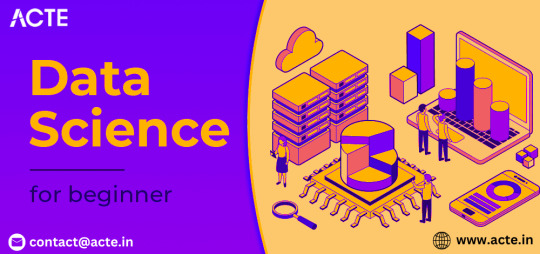
1. Establish a Strong Foundation in Mathematics and Statistics
Before delving into the specifics of data science, ensure you have a robust foundation in mathematics and statistics. Brush up on concepts like algebra, calculus, probability, and statistical inference. Online platforms such as Khan Academy and Coursera offer excellent resources for reinforcing these fundamental skills.
2. Learn Programming Languages
Data science is synonymous with coding. Choose a programming language – Python and R are popular choices – and become proficient in it. Platforms like Codecademy, DataCamp, and W3Schools provide interactive courses to help you get started on your coding journey.
3. Grasp the Basics of Data Manipulation and Analysis
Understanding how to work with data is at the core of data science. Familiarize yourself with libraries like Pandas in Python or data frames in R. Learn about data structures, and explore techniques for cleaning and preprocessing data. Utilize real-world datasets from platforms like Kaggle for hands-on practice.
4. Dive into Data Visualization
Data visualization is a powerful tool for conveying insights. Learn how to create compelling visualizations using tools like Matplotlib and Seaborn in Python, or ggplot2 in R. Effectively communicating data findings is a crucial aspect of a data scientist's role.
5. Explore Machine Learning Fundamentals
Begin your journey into machine learning by understanding the basics. Grasp concepts like supervised and unsupervised learning, classification, regression, and key algorithms such as linear regression and decision trees. Platforms like scikit-learn in Python offer practical, hands-on experience.
6. Delve into Big Data Technologies
As data scales, so does the need for technologies that can handle large datasets. Familiarize yourself with big data technologies, particularly Apache Hadoop and Apache Spark. Platforms like Cloudera and Databricks provide tutorials suitable for beginners.
7. Enroll in Online Courses and Specializations
Structured learning paths are invaluable for beginners. Enroll in online courses and specializations tailored for data science novices. Platforms like Coursera ("Data Science and Machine Learning Bootcamp with R/Python") and edX ("Introduction to Data Science") offer comprehensive learning opportunities.
8. Build Practical Projects
Apply your newfound knowledge by working on practical projects. Analyze datasets, implement machine learning models, and solve real-world problems. Platforms like Kaggle provide a collaborative space for participating in data science competitions and showcasing your skills to the community.
9. Join Data Science Communities
Engaging with the data science community is a key aspect of your learning journey. Participate in discussions on platforms like Stack Overflow, explore communities on Reddit (r/datascience), and connect with professionals on LinkedIn. Networking can provide valuable insights and support.
10. Continuous Learning and Specialization
Data science is a field that evolves rapidly. Embrace continuous learning and explore specialized areas based on your interests. Dive into natural language processing, computer vision, or reinforcement learning as you progress and discover your passion within the broader data science landscape.
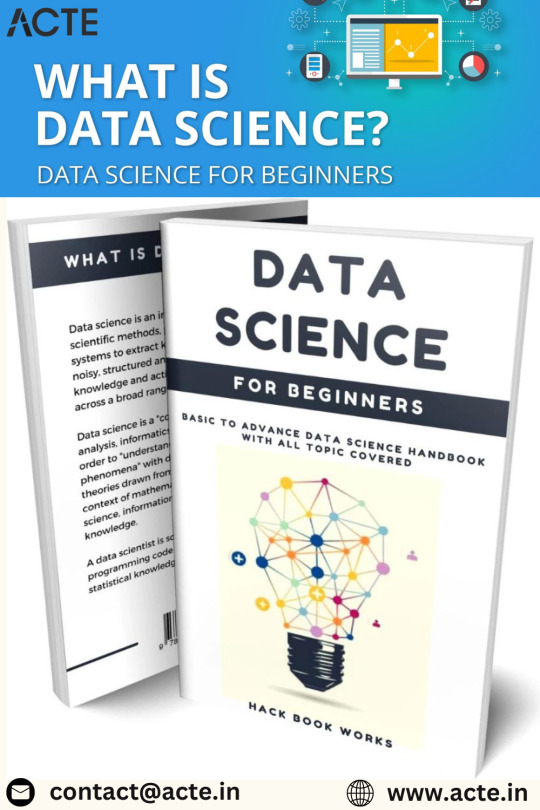
Remember, your journey in data science is a continuous process of learning, application, and growth. Seek guidance from online forums, contribute to discussions, and build a portfolio that showcases your projects. Choosing the best Data Science Courses in Chennai is a crucial step in acquiring the necessary expertise for a successful career in the evolving landscape of data science. With dedication and a systematic approach, you'll find yourself progressing steadily in the fascinating world of data science. Good luck on your journey!
3 notes
·
View notes